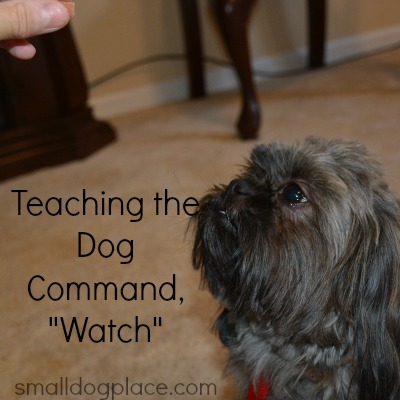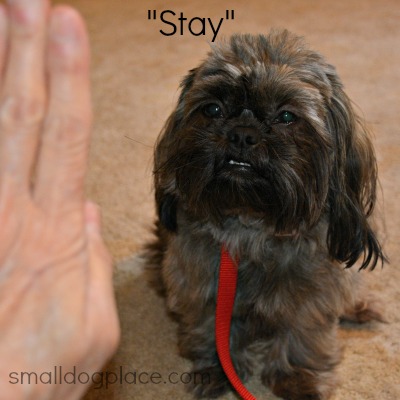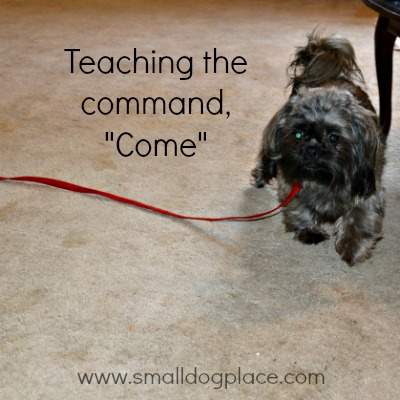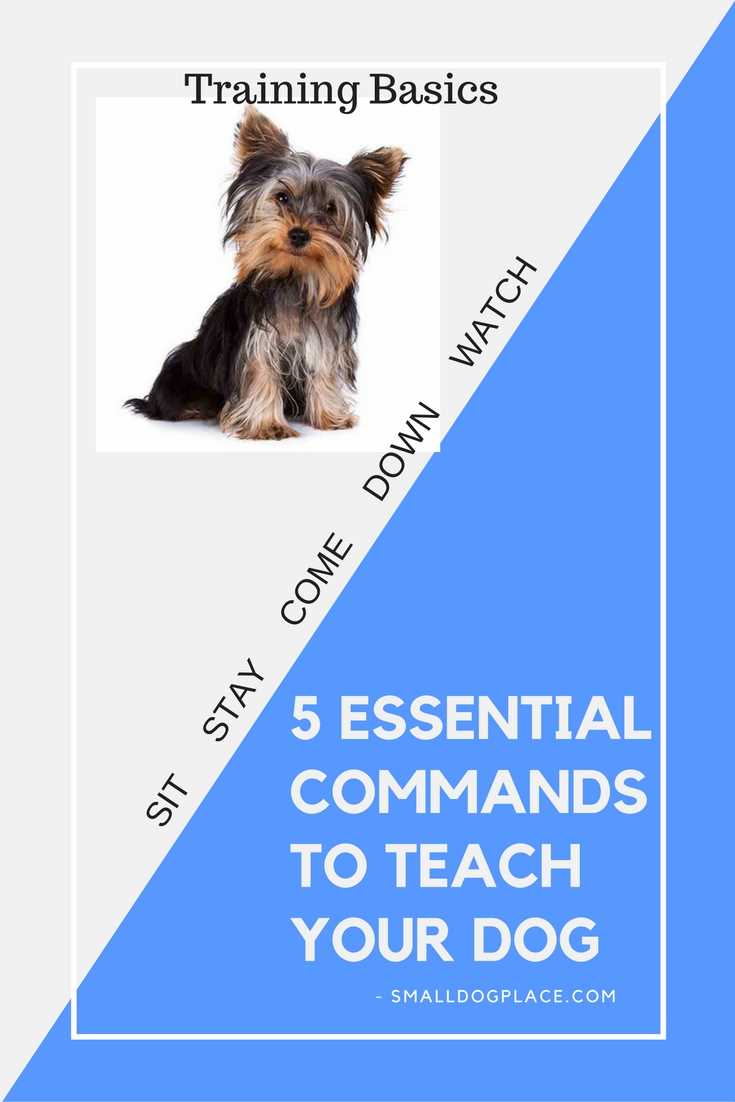- Small Dog Place Home
- Training
- Basic Dog Commands
5 Basic Dog Commands
Your Small Dog Should Know
Basic Dog Commands, by Janice Jones, Updated 03-24-2024
You just brought home your new puppy. Now it’s time to start training. But where do you start? Your new puppy has much to learn:
- How to recognize his own name?
- Where to go to the bathroom?
- What behaviors are acceptable, and what are not appropriate?
- Socialization to many different people, places, and things.
Complete training is beyond the scope of this article. I recommend that you check out some of the books in the reference section at the end of this post.
In this article, I will suggest five basic dog commands invaluable to your journey of molding a well-behaved, responsive, and joy-filled companion.
Drawing from hands-on experience with numerous pets and informed insights into dog behavior, I will walk you through each command, detailing the techniques, necessary aids, and potential setbacks.
Whether you're a first-time pet parent or an experienced dog owner looking to refine your training skills, buckle up and get ready to discover a rewarding path to effective dog communication and lasting canine companionship.
The five basic dog commands that all small breed dogs should know include:
I am not a professional trainer but I have trained many dogs over the years, taking numerous dog obedience classes with my dogs and read countless books on training.
For a fact, I know these simple techniques work for most dogs. Puppies are easier, but older dogs can be taught new tricks.
I chose one of my dogs to train for this article and photographed his progress along the way. I just wanted to be sure that even "old dogs can learn new tricks."
 Meet Toby, my brindle Shih Tzu. He is going to help demonstrate these commands.
Meet Toby, my brindle Shih Tzu. He is going to help demonstrate these commands.What Equipment do You Need?
To teach these basic dog commands, you will need:
- Tiny tasty treats
- Clicker (optional)
- Dog Leash
- Lots of Patience
- A positive approach
A little background and Training Terms
These five simple commands can be accomplished using a clicker training tool and tasty treats or simply using your voice to “mark” the behavior.
By “marking the behavior, I am referring to the particular behavior you want to see, whether it is to sit, stay, come, down or whatever.
I use the word “yes” said in a relatively enthusiastic voice to mark the behavior. Others find the clicker to work equally well.
Clicker-training using a metal clicker to make a sound that marks the behavior.
Clicker training is a nickname given to a positive reinforcement training system based marker training.
The psychology behind this approach is to teach the dog what you expect him to do first and then pair a verbal command such as sit or stay with his behavior.
It is a positive approach that rewards behaviors that are desired or incremental steps towards the behavior you want.
The click or a clicker or the word, “Yes” is meant to mark the behavior. The dog will begin to associate what he is doing with your click or verbal response and a food treat.
When I use the word ‘behavior,’ I’m referring to the task you want to accomplish. We’ll talk about five simple behaviors you can teach your dog in this article:
Watch me or Look, Sit, Down, Stay, and Come in this article.
Tips for Teaching Basic Dog Commands
-
All of these commands will take time
and repeated practice. Do not expect to
sit down with a new puppy and accomplish all of them in the first 10 minutes of
training.
- Short training periods are best for
very young puppies and then you can gradually increase the time you spend
training. Start with a five-minute
period and work up to 10 or even 15 minutes if you have your dog’s
attention.
- Pick a time when your dog is rested, and you are relaxed. Try to keep distractions to a minimum at
least at first.
- If you have a very distracted dog,
keep the sessions short. Always stop
before either of you gets frustrated or discouraged.
- The whole idea with positive training methods
is that training is fun and upbeat.
- Find a treat that your dog loves and
break it down into tiny, tiny pieces.
You don’t want to spend all your training time waiting for your dog to eat the treat.
- A trick most dog trainers will tell you is a must is a way to hold your training treats. Unless you plan to walk around with training treats in your hand, a little container or pouch is a must. These training treat containers are necessary so your hands are free and treats are readily available when there is a teachable moment. There are a variety of pouches to choose from and the one you chose must be personalized to your needs.
Basic Dog Commands: How to Teach Your Dog "Watch Me"
 Dog Command, "Watch"
Dog Command, "Watch"The "Watch Me" or "Look" command is meant to get and keep your dog's attention.
You may keep your dog on a leash. If you are in your home, you may not need a leash. Outside? Use a leash.
For this behavior, your goal is to get your dog’s attention in a positive manner. You want your dog to look at you.
- Take a tasty treat and hold it up
towards your face.
- When the dog looks up
at you, click and reward or say, “Yes” and reward.
- Do this
several times until he understands that he gets a food reward when he looks
at you.
- Once he has made this connection,
hold the food treat up and say, “look” or “watch me.”
- Reward when he does this. Repeat this several times until he is
consistently looking at you.
- Next, say the word without showing
the treat.
- Reward if your dog looks at you.
Eventually, you’ll want to reward intermittently, meaning that at first, every “look” gets a food treat but gradually, not every look will be rewarded.
It is best not to have a pattern such as
every 3rd look when you are teaching this basic dog command.
Keep the pattern random.
Basic Dog Commands: How to Teach Your Dog to "Sit"
 Basic Dog Command, "Sit"
Basic Dog Command, "Sit"- Hold a treat at the end of your small dog's nose.
- Slowly move the treat up and over the head.
- When he sits, praise with a word such as Yes or click
(if you are using the clicker method.
- Give the dog the treat.
What to do if the Dog Jumps Up or Backs Away
When teaching the "sit" command, if the dog jumps up, lower the treat.
If your dog backs up without sitting, back him into a corner and wait for him to sit. When he sits, mark it with an enthusiastic “yes" or click your clicker and give the treat.
Once he sits, say the word, "sit" to teach him the association with the word, the treat and his action.
You will need to do this repeatedly over time until he consistently knows the word and the action.
Once your dog sits easily on your cue, start to reinforce (treat, click and "yes" more intermittently. At first, every time the dog sits you will want to reinforce, but slowly skip one. Gradually, make your reinforcements even more random.
Basic Dog Commands: Teach Your Dog, "Down"
 Basic Dog Command, "Down"
Basic Dog Command, "Down"Once your little dog can sit, then it is time to teach him how to lie down.
- Put the dog in a sit position.
- Hold a treat in front of his
nose and move slowly straight down towards the floor to where his front
paws are resting.
- If he follows the treat all the way down, reward him with a click and treat or a “yes” and treat.
If the Dog Doesn't Go "Down"
If he doesn’t make it down onto the floor, start again but move the treat more slowly.
Click and
treat for any downward movement such as his head is down or moving his paw forward.
You may need to do these intermediate steps
until he figures out how to get down completely on the ground.
The technical term for rewarding these “baby
steps” is called shaping or rewarding
small parts of behavior until you see
complete success.
If you have no luck with this process, try it on a different floor surface such as a small mat, carpet, or hard floor surface – whatever you didn’t use in the beginning.
If Your Dog Stands instead of Going Down
- Does your dog stand as you move the treat down towards the
floor, put him back into a sitting position and begin to move the treat again
towards the floor, only this time do it even more slowly?
- If he continues to stand up, you can say
something like, “oops” which really means sorry, no treat for that.
- You may need to start again by repeating the same steps:
- Sit
- Move the treat downward slowly towards the floor
- Click and reward or say “Yes” and reward for every small step he makes until final success.
If these steps are not working, try this:
Sit on the floor with your knees raised. Have your little dog sit next to you. Hold the treat in one hand and place it under your knee to lure him under your leg.
He may lie down to get under you knee and craw forward to get his treat. If he does so, click and reward or say “yes” and reward.
Training is a slow process for some dogs. Do not get discouraged.
If you find yourself getting impatient or if the dog loses interest, stop the activity. Begin again when everyone is refreshed.
Basic Dog Commands: Teach Your Dog to "Stay"
 Basic Dog Command, "Stay"
Basic Dog Command, "Stay"At first, we will make this basic dog command short and easy. As the dog gains experience, you can increase the time you expect the dog to “stay.”
- Start in a sit or down position.
- Put the treat in front of the
dog’s nose and keep it there.
- Click or say “yes” several times while he’s in position,
then release him with a word you choose such as OK, done, free, etc.
- Once your dog will stay in the original position for a short
period of time (seconds not hours), add the verbal cue, “stay.”
- Pause, repeat the word, then click and reward.
- When you think, he is getting the idea, place the treat in
your other hand behind your back. Say, “Stay,” then reward.
- Gradually repeat this step increasing the time that he should stay.
When your dog can stay for 15 to 20 seconds, add a
distraction such as moving your feet or arms, or shuffling your feet.
Don’t add too much too soon. This is a harder command that requires our
patience and your dog's concentration.
After he can stay for 15 to 20 seconds with your distractions, start moving slowly away from him. Take a step back and then stop and return to him and reward.
Always go back to him rather than calling him to you. The come command will be covered next, but it is not part of learning to stay.
Basic Dog Commands: Teach Your Dog to "Come"
 Basic Dog Command, "Come"
Basic Dog Command, "Come"Also called a reliable recall, this command is more difficult to learn
and may be even more tough for some breeds. It is also the most important command you can teach, and one that could save your dog's life one day.
Your ultimate goal is to say the word, "come," and your dog immediately stops and comes to you without even thinking whether he’d like to do so or not.
Caveat: Don't call your dog to you to punish, reprimand or do something that the dog finds unpleasant such as taking a pill or getting his ears cleaned.
This is a challenging command and may take more time to master than the previous four behaviors.
- Place your dog on a 6 foot or longer leash. Hold the other end. You will use the dog’s name and the command,
“come.”
- Start by assuring there is a small distance between you and your dog.
- Place a treat in your hands where he can
see.
- Say his name and “come,” If he
comes toward you, mark the behavior with, “yes” or click and then reward. You may also want to pair getting the reward with you grabbing his collar or harness. (You don't want your dog to run away after he has successfully come)
- Repeat with your dog on a loose leash. Step back a couple of feet and call your dog again. Mark and reward.
- Repeat, each time moving farther away.
Doesn't Come?
Gently tug on the leash as you call his name and say the word come. If he gets up or makes some motion in your direction, reward.
Keep repeating this activity as long as your dog is interested, rewarding any "baby steps," or intermediate attempts to come.
Once the Dog Understands "Come,"
Once you think the dog understands this behavior, play the “coming game” in your house.
Have a supply of treats on you and call out your dog’s name and repeat, “come.”
Reward if he comes to you.
Go about your business and continue to ask the dog to come increasing the distance between you and the dog.
Continue until you can call your dog to you successfully when you are in one room and your dog in another.
Ready for the Outdoor "Come"
Do not practice this command outdoors in an open area until you are convinced the dog has a reliable recall.
A long training lead (10-12 feet) should be used when practicing this outdoors for safety reasons.
Continue to go through the same steps as above.
As you practice this skill, add even longer leads such as a 20-foot lead to increase the distance between you and your dog.
Some trainers recommend that you give your dog 3 treats every time he successfully comes when you call.
The rationale between this is that it takes about the same time to give 3 treats as it does to get your dog’s leash back on or in the case of a small dog, to pick him up to safety if he gets loose and you must call him to safety.
I think that is a good idea, but if you are going to do this, you must start training and rewarding with 3 treats each time.
Otherwise, your dog may not hang around long enough to get the three treats and then dart out again.
Once your dog is consistently performing these five basic dog commands, you will still want to practice periodically with and without treats.
Now it’s time to move on to some more challenging tasks.
Training should be an ongoing process throughout the dog’s life. It is a good way to bond and deepen the relationship over the years and a fun way for you to interact with your dog.
Basic Dog Commands: Special Circumstances
Frequently Asked Questions
Ideal Age to Start Training
Training should start as early as possible. Your puppy is about 7-8 weeks old and ready to learn basic commands. This is a critical period, as puppies are highly receptive to absorbing new information. In other words, training should begin when you bring your new furbaby home.
Managing Aggression During Training
If your dog shows signs of aggression during training, staying calm and assertive is essential. Avoid reacting negatively, as it could exacerbate the situation. Consider seeking advice from a professional trainer or a behavioral consultant.
How Many Times a Command Should be Repeated
Repetition is key in training. Each command should be repeated several times during a training session (15-20 times), and training sessions should be regular, ideally about 2-3 times a day. But everyone's schedule is different, so strive to turn traning sessions into your daily routine. (First thing in the morning, Breakfast, Other meal times, bedtime, etc.)
Maintaining Consistency in Dog’s Response
Consistency in issuing commands is crucial. Use the exact words and tone each time you issue a command. Consistent rewards for obedience also reinforce the behavior. That doesn't mean that you can't vary the food rewards if that is what you are using.
Effects of Punishment in Training
Punishment is not generally recommended. Instead, positive reinforcement—rewarding good behavior—tends to be more effective. Punishment can lead to fear and aggression and often does more harm than good.
Adapting Commands with Growth and Mental Development
Remember your dog’s physical and cognitive development. Modify the commands and training techniques as your dog ages to suit his abilities. Keep the training sessions engaging and relevant to his age and physical capabilities.
Puppies have short attention spans so training sessions should be short. Older dogs may have health problems where sitting may be painful. Consult your vet before starting a training program for an older dog.
Effect of Temperament, Breed, or Health Conditions
Like humans, every dog is unique. Certain breeds may be more responsive to training than others. A dog's temperament and health condition can also affect his learning capabilities. Always consider these factors during training. Please check your dog’s complete breed profile for more information.
More general information on Small Breed Dogs.
Training Visually or Hearing-Impaired Dogs
For dogs with hearing or visual impairments, touch or visually-based commands would work better. Consider using a touch signal or a vibration collar for hearing-impaired dogs.
For visually impaired dogs, use audible or touch commands. Always remember to adapt the training to suit the dog's ability.
This is a unique subject and the help of a professional trainer may come in handy.
Basic Dog Commands: Reference and Further Reading
The Art of Raising a Puppy by The Monks of New Skete: This book is an invaluable guide on understanding the nature of your furry companion and shaping his behavior with proper training from a young age.
Don't Shoot the Dog!: The New Art of Teaching and Training by Karen Pryor: A renowned dog trainer, Pryor provides insightful advice on positive reinforcement training methods in this book.
Dog Training for Dummies by Jack and Wendy Volhard: This easy-to-understand guide provides valuable strategies for training dogs, making it a great reference for beginners.
How to Behave So Your Dog Behaves by Dr. Sophia Yin: This book offers expert solutions to common canine behavior problems, making it a helpful resource for any dog owner.
The Other End of the Leash: Why We Do What We Do Around Dogs by Patricia McConnell: A leading expert in animal behavior, McConnell explores the interaction between humans and dogs in this book, providing valuable perspectives for training.
About Janice (author and voice behind this site)
Having lived with dogs and cats most of her life, Janice served as a veterinary technician for ten years in Maryland and twelve years as a Shih Tzu dog breeder in Ohio.
Her education includes undergraduate degrees in Psychology with a minor in biology, Early Childhood Education, and Nursing, and a master's in Mental Health Counseling.
She is a lifelong learner, a dog lover, and passionate about the welfare of animals. Her favorite breed for over 50 years has been the Shih Tzu, but she has also lived with Poodles, Maltese, Yorkshire Terriers, Beagles, English Bulldogs, Carin Terriers, and a Cocker Spaniel.
When not writing, reading, and researching dog-related topics, she likes to spend time with her eight Shih Tzu dogs, husband, and family, as well as knitting and crocheting. She is also the voice behind Miracle Shih Tzu and Smart-Knit-Crocheting
Does This Article Deserve Your Thumbs Up?
We always appreciate your support and encouragement. Your thumbs up means so much to us. Please like this article.
If you find this page or any page on Small Dog Place Helpful, or useful in anyway, I'd love it if you would click the small heart found on the bottom right of each page.
You can also share or bookmark this page -- just click on the:

Free Monthly Newsletter
Sign Up for Our Free Newsletter and get our Free Gift to You.
my E-book, The Top 10 Mistakes People Make When Choosing a Dog (and how to avoid them)


